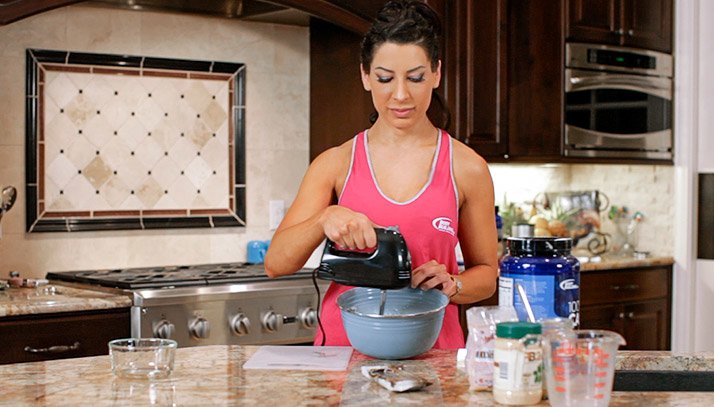
Fitness 360: Dr. Sara Solomon, Nutrition Program
Dr. Sara Solomon's nutrition philosophy fits her on-the-go schedule. She doesn't weigh her meals or spend hours packing Tupperware. She stays ripped, and full, with a technique called intermittent fasting.
Solid nutrition is the key to growth, but that doesn't mean you need to graze throughout the day. Sara tried the six meals per day approach, but it wasn't for her.
Luckily, Sara found a different approach that worked for her body and lifestyle. Sara meets her macros, achieves satiety, and even makes room for daily cheat meals with intermittent fasting.
Dr. Sara Solomon Fitness 360
Watch The Video - 15:35
Fasted Feasting
Instead of eating every few hours, Sara schedules all of her meals within a four-hour window. "I spend 20 hours of my day fasted—meaning no food goes into my mouth," she explains. Sara has been combining intermittent fasting and short-duration, high-intensity training since August 2012—she even blasts through those tough workouts fasted—and she's now ripped like a ticket stub year-round.
As for being hungry throughout the day, well, Sara isn't. "A lot of people ask me 'Wow, Sara, don't you get hungry if you're not eating for 16-20 consecutive hours?'" she says. "The answer is 'No, I don't.'" In fact, she's much less hungry than she was before. "I was always hungrier than a hostage in a holdup," Sara says. "It became a food obsession. I was constantly bingeing and cheating between meals."
Thus, intermittent fasting helps Sara keep her sanity while losing her unwanted body fat. "When you're constantly stuffing your face with food, your insulin levels are always elevated," Sara says. "When that happens, your fat oxidation—your body's ability to burn fat—shuts off. If you're not eating, you enter fat oxidation mode and you can actually burn fat. I'm able to tap into my stored fat for energy during my 20-hour fast."
Any hunger (or thirst) she feels is quenched with water, BCAAs, and green tea. An added benefit of intermittent fasting? You know when you're truly hungry. "There's a big difference between true hunger and psychological hunger and thirst," Sara says. "When you start fasting, you learn quickly when you're truly hungry versus when you just think you're hungry."

Sara saves her four-hour feasting window for the end of the day—a nighttime treat if you will. "I've always associated nighttime with pigging out," she admits. "I come home from work after a long day and I just want to eat and eat and eat everything. Intermittent fasting gives me the opportunity to eat all my calories at once."
While it might seem restrictive, intermittent fasting actually has a good amount of wiggle room. For Sara, flexibility is the key. She can choose to eat six mini-meals in her feasting period or down everything at once. "If I want to go to Benihana and eat all my calories at once, I'll do that," she says. "If I feel like having five meals during my four-hour window, I'll do that. I don't follow some sort of a rigid format because when I do that I'm setting myself up for failure."
For Sara, a higher-protein diet helps her lose fat without sacrificing muscle. She consumes 1.1-1.2 grams of protein per pound of body weight per day, gets 15-25 percent of her calories from fat sources, and saves the rest for carbs.
Sara also makes time for what's important: treats. "As long as I'm meeting my macronutrient and micronutrient needs, and getting my daily fiber intake of at least 20 grams per day, I know I can have fun selecting the foods I want to eat," she says. "That's how I can get away with my daily discretionary calories of eating a handful of licorice, because some things haven't changed since university."
Sample Intermittent Fasting Meal Plan
Other than the BCAAs she takes around her morning HIIT session, Sara limits her nutritional intake to a four-hour window in the evening. You can try this approach every day, or every other day—experiment to see what works for you. More information about her fasting protocols is available at DrSaraSolomon.com.

BSN aminox 1 scoop

Green tea 1 cup
5 p.m.-9 p.m.: FEAST
- 4 hours to eat: 1,600 calories, 150 g protein, 30 grams of fat, 125 grams of carbs and at least 25 grams of fiber.
- Break the fast with raw veggies: high fiber, high water content, and limited calories.
- Then eat cooked foods such as: grilled veggies and lean protein (chicken, fish, eggs, whey, Greek yogurt, cottage cheese, Quest Bars, and recipes using BSN's Syntha-6 Whey and Syntha-6 Isolate. Find Sara's recipes at DrSaraSolomon.com!
- Finish feast with complex carbs (fruit, yams, oats, P28 Bread) and slow-digesting protein, such as casein or cottage cheese.
- Use discretionary calories to fill any calorie deficit.
- On low-carb days, finish feast with healthy fats (nuts, nut butters, and flax) instead of carbs.
- Stop eating when you feel more thirsty than hungry.
Feel free to ask any questions in the comments below. Meantime, here are my answers to some FAQs:
Why break a fast with raw veggies?
Raw veggies have high fiber and water content and few calories. This applies the principle of volumetrics and helps reduce overall calorie consumption for the rest of my feast. In other words, it helps prevents a bingefest.
Why save carbs until the end of a feeding window?
This strategy keeps insulin secretion under control. When veggies are eaten first, followed by protein and fat, the glycemic index of any carb (even candy!) that is consumed afterward is reduced.

According to a 2011 study in the journal "Obesity," consuming most of your carbs at dinner leads to greater weight loss. Why? Eating carbs at night will induce a single daily insulin secretion in the evening.
This will boost leptin levels 6-8 hours later, which will contribute to enhanced satiety during the next day's fasting window.
Why finish with slow-digesting proteins?
Slow-digesting proteins provide a steady supply of amino acids to your muscles during your fast for up to 8 hours, which promotes satiety and minimize muscle catabolism.
Remember, the goal is to burn fat, not muscle!

